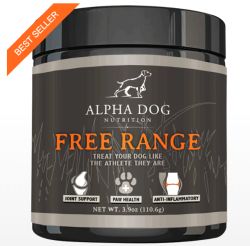Nutraceuticals – essentially foods or supplements that provide health benefits that exceed their nutritional value – appeal to many dog owners, and they are currently administered to treat a range of conditions.
Glucosamine is one of the most commonly used nutraceuticals, and it is often used to in the treatment of osteoarthritis in dogs, as well as other causes of joint pain.
Below, we’ll explain what glucosamine is, the conditions it’s used to treat and compare the different forms in which it is available.
Want answers fast? Check out our quick picks below, or keep reading for more information and detailed reviews.
Best Glucosamine for Dogs: Quick Picks
- #1 COSEQUIN Maximum Strength Joint Supplement Plus MSM [Best Glucosamine Chewable Tablets for Dogs]: Formulated with glucosamine, chondroitin, MSM, and manganese, these tasty chicken-flavored tablets are a great choice for many doggos.
- #2 Alpha Dog Nutrition FREE RANGE Joint Supplement [Best Glucosamine Powder for Dogs]: An easy-to-administer, beef-flavored powder made with glucosamine, chondroitin, and MSM, that’s specifically intended for active four-footers.
- #3 Liquid Health K9 Level 5000 [Best Glucosamine Liquid for Dogs]: In addition to chondroitin and MSM, this beef-flavored liquid features two different forms of glucosamine and can simply be added to your pet’s food.
What Is Glucosamine?
Glucosamine is a naturally occurring amino sugar that is an important component in the synthesis of several different biological substances. It is used in the production of several lipids (fats) and proteins, and it is an important component of the external shells of crustaceans and other arthropods.
However, the most noteworthy role played by glucosamine is in the production of tendons, ligaments, cartilage and synovial fluid – a thick liquid found in most of the joints in your dog’s body. Technically, these tissues are created from compounds called glycosaminoglycans, and glucosamine is thought to stimulate the production of these chemicals.
Your dog’s body produces glucosamine naturally, but it is also used as a supplement by humans and companion animals, including dogs, cats, and horses, among others. It is thought by many to provide several different therapeutic benefits, but it is primarily used to treat painful or arthritic joints.
Glucosamine is available in several different forms. The two most common forms glucosamine takes include glucosamine sulfate and glucosamine hydrochloride. Although most of the research conducted thus far has targeted glucosamine sulfate, both forms appear to work for dogs.
It is worth pointing out that glucosamine hydrochloride is the purer of the two forms, so, given equal amounts of glucosamine sulfate and glucosamine hydrochloride, the sample of the hydrochloride form will contain more glucosamine.
Commercially, glucosamine is either derived from natural sources (like crustacean shells) or produced through the fermentation of grains.
Though we can’t find research analyzing the relative efficacy of the different forms glucosamine supplements for dogs take, it seems likely that all three types (powders, chewables, and liquids) are equally effective.
Accordingly, ease of administration is the primary thing owners should think about when picking a specific product. There is no one-size-fits-all answer here; different dogs and owners will find different forms of glucosamine best. But here is a bit of food for thought to help guide you to the right answer:
- Chewables are great for dogs who will take them, as they needn’t be mixed with anything or prepared in any way at all. You simply grab one and give it to your dog like a treat. Problems can arise, however, if your dog doesn’t like the taste.
- Powders are likely the easiest type of glucosamine supplement to administer to your dog. You can simply sprinkle the recommended quantity on your dog’s food, or you can mix it with a little water to create a supplemental “gravy.” Note that some powders appear extremely unpalatable, but most dogs seem to like the taste of the one we recommend below.
- Liquids are easy to administer, as they can simply be added to your dog’s food. Alternatively, you can administer them directly in your dog’s mouth via an eye dropper if he doesn’t mind the taste. Just note that — unlike most powders — some liquid supplements require refrigeration.
The 3 Best Glucosamine Supplements for Dogs: Liquid, Chewables, and Powders, Oh My!
As mentioned, glucosamine supplements typically come in liquid, chewable or powdered form. We’ll discuss our favorites — including one of each type — below! Just try to pick the one that’ll be easiest to serve up to your pooch.
#1 Nutramax Cosequin DS Plus with MSM Chewable Tablets
About: Nutramax Cosequin DS Plus Chewable Tablets are easily the best option for owners seeking a chewable glucosamine supplement. Made with an assortment of joint-supporting compounds, these chicken-flavored tablets are quick-and-easy to administer for many dogs.
This is a sponsored placement, in which an advertiser pays a fee to be featured in this article. Learn more
Features:
- Contains glucosamine hydrochloride, sodium chondroitin, and MSM
- Each chewable tablet contains 600 milligrams of glucosamine
- Chicken-flavored
- Requires no refrigeration
Pros
- Multi-ingredient supplement that supports joints in several ways
- Chewable tablets require no scooping, mixing, or pouring
- Nutramax is one of the leading manufacturers in the joint-support category
- Great choice for traveling owners
Cons
- Formulated with natural AND artificial flavors, which may give some owners pause
- Some dogs appear to find them unpalatable
#2 Alpha Dog Nutrition FREE RANGE Joint Supplement
About: Want a powdered glucosamine supplement that also features several other joint-supporting ingredients? Well, Alpha Dog Nutrition FREE RANGE is easily the best choice in the category. Designed specifically for active and working dogs (though still suitable for canine couch potatoes), this supplement can help support mobility and limit joint-related pain.
This is a sponsored placement, in which an advertiser pays a fee to be featured in this article. Learn more

Alpha Dog Nutrition FREE RANGE Joint Supplement
An easy-to-administer glucosamine powder that also contains chondroitin, MSM, and supplemental vitamins.
Features:
- Made with glucosamine, chondroitin, and MSM
- Fortified with brewer’s yeast (a great source of B-complex vitamins)
- Each scoop provides 700 milligrams of glucosamine
- Beef-flavored
Pros
- We love that it’s specifically designed for active and working dogs
- Most dogs appear to like the beef flavoring
- One of the few glucosamine supplements with supplemental B-complex vitamins
- Does not require refrigeration
Cons
- There are more affordable options, though this still provides great value
- Safe for low-activity dogs, but may provide more supplementation than necessary
#3 Liquid Health K9 Level 5000
About: Though they’re not as popular as powders and chewables, liquid glucosamine supplements work very well for some dogs and their owners. And for these canine-human pairs, Liquid Health K9 Level 5000 is clearly one of the best options on the market.
This is a sponsored placement, in which an advertiser pays a fee to be featured in this article. Learn more
Features:
- Made with 2 different forms of glucosamine
- 866 milligrams of total glucosamine per teaspoon
- Also formulated with chondroitin and MSM
- Chicken-flavored
Pros
- Owners love that it contains 2 forms of glucosamine
- Most dogs appear to enjoy the taste
- It’s easy to mix with dog food, given its liquid form
- Also contains supplemental antioxidants
Cons
- Requires refrigeration after opening
- Relatively pricey
Conditions that Glucosamine May Treat: The Benefits of Glucosamine

Although there is some dispute about the effects of glucosamine and its ability to treat various health conditions (more on this below), it is primarily used to treat various joint diseases.
This means glucosamine is potentially helpful in the following scenarios:
- Dogs with osteoarthritis
- Dogs with hip dysplasia
- Dogs with elbow dysplasia
- Dogs with spinal disc disease
It is also used to help accelerate the healing process following surgery or traumatic injuries, as well as a performance-boosting supplement for active dogs. Humans can use glucosamine to treat similar issues, including knee problems and osteoarthritis (as well as the reduced range of motion these conditions often cause).
The rationale behind the use of glucosamine is that it will aid the body in regenerating healthy cartilage and joint-protecting compounds, which will help reduce and repair the damage caused by joint diseases, overuse, or improper structure. It is also used as a preventative supplement in dogs who are at risk for joint problems.
Dogs Who May Benefit from Glucosamine Supplements: Will Glucosamine for Dogs Help Your Pet?

Even though glucosamine is typically considered a very safe supplement, it is wise to discuss the issue with your vet before initiating a supplementation regimen. However, some of the dogs who may benefit from the supplement include:
- Large breeds, for whom hip dysplasia, elbow dysplasia, and arthritis are common
- Overweight dogs, whose joints are forced to support more weight than necessary
- Highly active dogs, whose joints suffer from a lot of wear and tear
- Dogs genetically predisposed to dysplasia or other joint problems
- Dogs who’ve had surgery
- Dogs who’ve suffered a traumatic joint or spinal injury
Keep in mind that even dogs with healthy joints may benefit from taking a glucosamine supplement in preventative fashion. This is especially true of highly active or working pooches.
Just remember to discuss the issue with your vet before starting a supplementation regimen.
Keep in mind that some joint ailments are associated with other health issues. For example, osteoarthritis in dogs is more likely to cause problems for pooches who’re overweight.
Accordingly, part of the treatment for osteoarthritis in dogs (aside from initiating a glucosamine regimen) may include steps to reduce your pet’s body weight. This essentially gives you a two-for-one chance to help reduce arthritic pain.
Scientific Evidence: Does Glucosamine for Dogs Actually Work?

Glucosamine is widely recommended by human doctors and veterinarians, and they have been for decades (glucosamine was first isolated in 1876, although it wasn’t well understood until the 1940s).
However, empirical studies investigating its efficacy have been a bit of a mixed bag: Some scientific evidence has found that glucosamine is at least moderately effective for treating osteoarthritis and other joint problems, while others have found it no more helpful than a placebo.
The overwhelming scientific consensus? More research is necessary to obtain more clinical evidence of its value. Glucosamine may be helpful; it may also provide no real therapeutic benefit.
Most of these studies have focused on the human use of glucosamine (there’s much more funding available for human-based research than veterinary studies), but because our joints are pretty similar to those of dogs, the results of human studies may very well provide valuable data for pet owners and vets too.
Takeaways from a few of the most relevant studies are listed below:
- A three-year-long study of 212 human patients with osteoarthritis of the knee compared the results of those given glucosamine sulfate, with those given a placebo. The results, which were published in 2001, demonstrated that the placebo group suffered more joint space loss than those given glucosamine. Further, positive results were recorded when the placebo group was subsequently administered glucosamine.
- A 2006 study published in the New England Journal of Medicine found that “Glucosamine and chondroitin sulfate alone or in combination did not reduce pain effectively in the overall group of patients with osteoarthritis of the knee.” However, the researchers contended that “the combination of glucosamine and chondroitin sulfate may be effective in the subgroup of patients with moderate-to-severe knee pain.”
- A 2002 study published in the Journal of the American Medical Association found that “Symptoms improved modestly with placebo use but as much as 20% to 25% with glucosamine sulfate use.” The researchers noted particular improvement with respect to pain, joint function, and stiffness.
- A 2001 study of dogs found that “Our study of a canine model of surgically induced OA (osteoarthritis) is among the first to provide in vivo evidence that chronic oral administration of CS–G–M resulted in modulation of articular cartilage metabolism that was reflected in synovial fluid 3B3 and 7D4 epitope concentrations,” which essentially means that glucosamine administration changed the chemistry of the fluid in a dog’s joints. This provides some support for the use of glucosamine in dogs.
- A 2000 review found fault with many of the studies investigating glucosamine and chondroitin supplementation but concluded that “some degree of efficacy appears probable for these preparations.”
- A 2007 review of various clinical trials investigating osteoarthritis treatments was published in the Journal of American Veterinary Medical Association. The reviewers concluded that “A moderate level of comfort exists for… a combination of chondroitin sulfate, glucosamine hydrochloride, and manganese ascorbate.”
This is just a small sampling of the research that has been conducted on the subject. Some of this research is obviously somewhat contradictory, so you’ll need to research the issue carefully and work closely with your vet to determine whether glucosamine may be helpful for your dog.
Typical Glucosamine Dosage for Dogs: How Much Glucosamine Does My Dog Need?

Because the FDA does not approve glucosamine or other nutraceuticals, no official or correct dosage is recognized.
Nevertheless, standard practices typically call for 500 milligrams of glucosamine per 25 pounds of body weight every 12 hours. In other words, you’ll want to give your 50-pound pit bull mix about 1,000 milligrams in the morning and another 1,000 milligrams at night.
Glucosamine is generally thought to take four to six weeks to generate positive results. After all, it takes time for your dog’s body to create cartilage and other joint tissues. Accordingly, you’ll have to be a bit patient when initiating a supplementation regimen.
Once you start to see a reduction in your dog’s symptoms (such as reduced pain or improved mobility), it is often recommended that you reduce the dosage given to perhaps half of what you were providing. This will hopefully allow you to determine the minimum effective dose for your dog.
If your dog’s condition continues to improve, you can reduce the dosage even further. If, however, the negative symptoms reappear, or your dog’s condition worsens, you’ll need to gradually increase the dosage again.
Different dosages may be required to address different types of joint problems in dogs. For example, dogs with osteoarthritis may need more or less glucosamine than dogs with hip dysplasia.
You’ll simply need to discuss your pet’s health with your vet to decide on the best dosage.
Can I Give My Dog Glucosamine Made for People?

Probably, but it is not a good idea.
As previously discussed, glucosamine is available in several different forms. And while some appear to be more effective than others, there is no real difference between the glucosamine used in human supplements and that which is used in canine supplements.
Glucosamine sulfate, for example, is glucosamine sulfate – there’s no real difference between that formed in your dog’s body and that formed in yours.
This would seem to indicate that you can, in fact, use human-intended sources of glucosamine for your pup. However, in addition to the active ingredients, there are a number of inactive ingredients used in the production of glucosamine supplements for people, and some of these may be harmful to your dog.
As long as you select a product that doesn’t contain dangerous additives, there is nothing wrong with giving your dog sources of glucosamine designed for people. But few people will do the necessary homework to ensure they aren’t giving their dog a supplement with dangerous ingredients.
Accordingly, it is generally wisest to choose a glucosamine supplement made by a reputable manufacturer and explicitly intended for canine use.
What About Glucosamine-Fortified Foods?

Many premium dog foods are fortified with glucosamine, chondroitin and other joint supplements. This causes many owners to wonder if they really need a supplement, or if one of these foods can provide all of the glucosamine their dog needs.
Unfortunately, while several foods do include the supplement, they generally only contain a relatively low concentration of glucosamine – far below that which is typically recommended for supplementation.
Let’s take an example: Wellness CORE Natural Grain-Free – specifically their Large Breed formula.
This recipe – like most other Wellness recipes – is quite impressive and features most of the things you’d want in a dog food. We’ve recommended several of these recipes in our food reviews.
Wellness CORE Grain-Free is very nutritious, it is loaded with premium ingredients, and it contains all of the bells and whistles an owner could want. It is also fortified with several valuable supplements, including glucosamine. Long story short, it’s a 4½- to 5-star product, depending on the situation and your dog’s needs.
According to the label, Wellness CORE Grain-Free (Large Breed) contains “Not Less Than” 750 milligrams of glucosamine per kilogram of food (it also provides “Not Less Than” 250 mg/kg or chondroitin).
That sounds like a reasonable amount of glucosamine – until you do the math:
Most guidelines recommend providing a 100-pound dog with 4,000 milligrams of glucosamine every day (split into two doses). That means your dog would need to eat 5.3 kilograms of food each day to see any real benefit from the added glucosamine.
I know these metric units are baffling to most of us Americans, so let me put that into better context: 5.3 kilograms of food is 50 cups, give or take. That’s something like 17,000 Calories. That’s more than a male lion needs every day. It is about 10 times the amount of food our hypothetical 100-pound dog needs.
We looked at the glucosamine content of several other premium foods (including Instinct Raw Boost, Merrick Grain-Free, Blue Buffalo Life Protection, and NUTRO ULTRA Senior) but none have significantly more glucosamine (or other active ingredients that’ll support your pet’s joint health) than Wellness CORE does.
A few have much less, and some fail to indicate the amount contained at all.
So, it is unlikely that your dog will ingest the recommended daily dose of glucosamine from his food. It is conceivably possible that some joint health dog food diets are packed with about 10 times the glucosamine that these foods are, but I don’t think it is very likely.
However, you could ask your vet about prescription joint-health dog foods, as some may contain more glucosamine than over-the-counter alternatives.
Does Glucosamine Present any Risks?

Glucosamine is generally considered a safe supplement, which rarely causes health problems or adverse effects. However, a few minor problems are occasionally noted, including:
- Mild intestinal disturbance
- Rash
- Fatigue
- Insomnia and sleep disturbances
- Excessive thirst
- Excessive urination
Some doctors and veterinarians are concerned that because glucosamine is a sugar, it may trigger diabetes or cause problems with insulin resistance. Accordingly, you should consult your vet before administering it to a diabetic dog. It has also been shown to increase cholesterol levels in some animals, and there is a possibility that it may increase blood pressure too.
Blood-thinning medications may interact with glucosamine, so dogs taking such medications should not be given glucosamine without veterinary approval. It is also important to discuss your dog’s glucosamine usage with your vet if your dog requires surgery. Few studies have been conducted on pregnant or lactating dogs, so care is required in these situations.
Additionally, because many glucosamine supplements are derived from crustaceans, humans or dogs who’re sensitive to shellfish may experience an allergic reaction. So, four-footers with allergies to these types of critters should avoid supplements harvested from such sources.
Although adverse effects are somewhat rare following the administration of glucosamine supplements, it is wise to monitor your mutt carefully — especially at the outset. Report any adverse effects you notice promptly and heed any advice your vet provides.
What Other Treatment Strategies Are Effective Alongside Glucosamine?

Realize that while glucosamine may very well help treat hip dysplasia, arthritis, and other joint ailments, there are a number of other treatment strategies that can be implemented concurrently, to help give your pup the best chance at recovery.
Some of the most notable strategies include:
Weight Loss
All owners should strive to keep their dog’s body weight in the ideal range, as obesity can cause a number of health problems. However, weight loss is often especially critical when treating problems with your dog’s hip joints, as well as elbow, knee, or back problems, as excessive weight burdens your dog’s bones and joints.
Just be sure that you help your dog lose weight gradually and in a safe manner – don’t just start withholding food. Begin by cutting out all of the empty calories your dog receives (including treats and people food), and then, switch to a low-calorie food or simply reduce the quantity you feed your dog slightly.
In most cases, you’ll want to consult with your vet while trying to get your dog to lose weight.
Exercise
Exercise can help improve mobility and your dog’s mental well-being (which is helpful in treating just about any ailment). Exercise can also help strengthen the muscles around the ailing joints, which can help support the joint and improve your dog’s quality of life.
However, it is important that your dog gets exercise in the right way, as overuse is one of the primary causes of joint problems in the first place. Typically, this means you’ll want to provide your dog with low-impact exercises that won’t cause a lot of stress on his shoulder, elbow, and hip joints.
Because the water will support your dog’s body and it doesn’t involve much impact, swimming is one of the best options for dogs who are healthy enough to do so safely.
NSAIDs
Nonsteroidal anti-inflammatory drugs are sometimes effective at reducing the pain and inflammation that accompanies canine arthritis, dysplasias, and other joint problems. While you should never give your dog an NSAID without first consulting your vet, they are generally regarded as safe when used properly.
Aspirin and ibuprofen are two of the most common NSAIDs used in humans, but there are a litany of drugs in this class, including several that are specifically formulated for canine use. Some of these include:
- Carprofen
- Deracoxib
- Firocoxib
- Meloxicam (Also goes by brand name Metacam)
Physical Therapy
Canine physical therapists may be able to provide your dog with some pain relief and improve your dog’s mobility through various stretches, exercises, and stimulation techniques. You’ll have to cough up a bit of cash to obtain the services of a qualified canine physical therapist, but the results often justify the cost.
Chondroitin
Chondroitin is another naturally occurring compound that is important in the production and maintenance of cartilage in your dog’s hip joints, as well as his elbows, shoulders, and spine.
Chondroitin is often given in conjunction with glucosamine, and some studies have shown that the combined effects of the two supplements exceed those produced by either supplement by itself. Like glucosamine, chondroitin is largely considered safe, although its efficacy is similarly unclear.
Omega-3 Fatty Acids
Omega-3 fatty acids are important for a variety of biological processes, and they exhibit a pretty significant anti-inflammatory effect, which can help reduce your dog’s pain. Omega-3 fatty acids are available as standalone supplements, and you can also provide them via your dog’s diet. Many fish-derived oils are rich in omega-3s, as are some other dietary supplements, such as flaxseed-based products.
Methylsulfonylmethane (MSM)
MSM is another naturally occurring substance that some contend supports joint health and counteracts the pain and mobility limitations caused by osteoarthritis. Like glucosamine and chondroitin, there’s mixed evidence regarding its efficacy and it is largely considered safe. Accordingly, it is often used in conjunction with glucosamine and is present in many supplements.
A Spoonful of Sugar: Getting Your Picky Eater to Take Her Glucosamine

Some of the glucosamine supplements on the market are unpalatable to dogs. This can make it difficult to get your furry friend to swallow a glucosamine-rich nutritional supplement, and leave you frustrated and prevent your dog from getting better. Fortunately, there are a few tricks you can embrace to help make the process go easier.
Mix Powders or Liquids in With Your Dog’s Food
Most glucosamine powders and liquids are designed to be mixed with your dog’s food (although liquids can sometimes just be dispensed on your dog’s tongue). However, your dog is more likely to slurp up their medicine if you mix it in with something truly delicious. A few of the best mixers include:
- Peanut butter
- Olive oil
- Butter
- Fish oil
- Low-fat cheese spread
- Chicken fat
- Beef fat
- Bacon fat
Don’t get carried away with these high-calorie mixers – you don’t want to give your dog a gut while trying to get him to take his medicine. We’re talking about using a tablespoon or so for a big dog, and perhaps only a teaspoon’s worth for a little yapper.
Use Pill Pockets
There are a number of commercially produced “pill pockets” designed to help mask the flavor of supplements and medications. Most are essentially small treats that feature a hidden pocket, into which you can put a tablet or capsule.
Greenies makes a great pill pocket, which is available in a few different flavors.
Use Cheese as a Trojan Horse
You can co-opt the pill pocket idea by simply inserting a pill or capsule in a small piece of cheese. You’ll have to engage in a little bit of cheese surgery to do so, but with a little practice, you’ll find this pretty easy to do. The little cubes of cheese available at most grocery stores will work well for medium to large dogs.
If you have a small pup or one that is overweight, you may want to opt for a low-fat cheese, rather than the full-fat stuff.

***
Do you have a pupper suffering from joint pain? Do use glucosamine as a preventative measure to help support your dog’s joints? Have you tried any other supplement for dogs? How have they worked for you? Have you noticed any improvements in your dog’s condition since beginning the practice? Did a glucosamine supplement allow you to avoid joint surgery for your dog?
We’d love to hear about your experiences. Especially those involving tangible differences in your dog’s mobility. Let us know all about it in the comments below.











No Comments